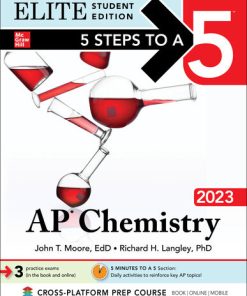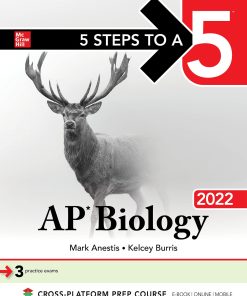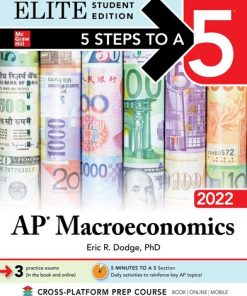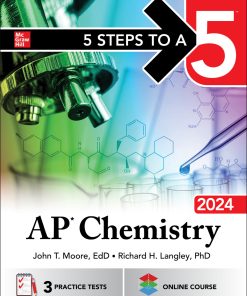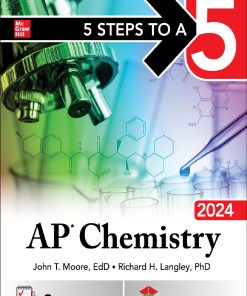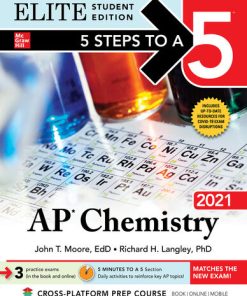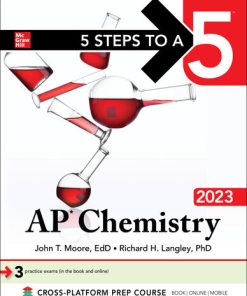(Ebook PDF) 5 Steps to a 5 AP Chemistry 2022 1st edition by John Moore, Richard Langley ISBN 9781264267972 1264267975 full chapters
$50.00 Original price was: $50.00.$25.00Current price is: $25.00.
(Ebook PDF) 5 Steps to a 5 AP Chemistry 2022 1st edition by John Moore, Richard Langley-Ebook PDF Instant Download/Delivery:9781264267972, 1264267975
Instant download Full Chapter of 5 Steps to a 5 AP Chemistry 2022 1st edition after payment
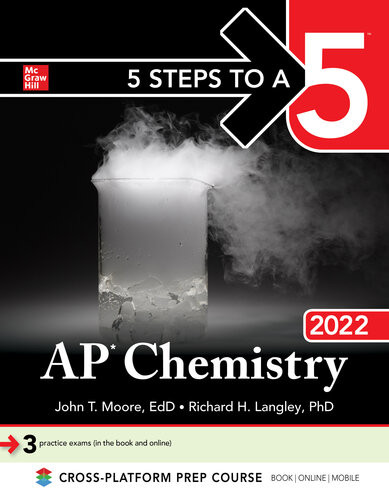
Product details:
ISBN 10: 1264267975
ISBN 13: 9781264267972
Author: John T. Moore , Richard H. Langley
MATCHES THE LATEST EXAM!
Let us supplement your AP classroom experience with this multi-platform study guide.
The immensely popular 5 Steps to a 5: AP Chemistry guide has been updated for the 2021-22 school year and now contains:
- 3 full-length practice exams (available both in the book and online) that reflect the latest exam
- Access to a robust online platform
- Comprehensive overview of the AP Chemistry exam format
- Hundreds of practice exercises with thorough answer explanations
- Proven strategies specific to each section of the test
- A self-guided study plan including flashcards, games, and more online
Table of contents:
- Introduction: The Five-Step Program
STEP 1 Set Up Your Study Program
- 1 What You Need to Know About the AP Chemistry Exam
- Background of the Advanced Placement Program
- Who Writes the AP Chemistry Exam?
- The AP Grades and Who Receives Them
- Reasons for Taking the AP Chemistry Exam
- Questions Frequently Asked About the AP Chemistry Exam
- 2 How to Plan Your Time
- Three Approaches to Preparing for the AP Chemistry Exam
- Calendar for Each Plan
STEP 2 Determine Your Test Readiness
- 3 Take a Diagnostic Exam
- Getting Started: The Diagnostic Exam
- AP Chemistry Final Practice Exam, Section I (Multiple Choice)
- Answers and Explanations for Final Practice Exam, Section I (Multiple Choice)
- AP Chemistry Final Practice Exam, Section II (Free Response)
- Answers and Explanations for Final Practice Exam, Section II (Free Response)
- Scoring and Interpretation
STEP 3 Develop Strategies for Success
- 4 How to Approach Each Question Type
- Multiple-Choice Questions
- Free-Response Questions
STEP 4 Review the Knowledge You Need to Score High
- 5 Basics
- Units and Measurements
- Dimensional Analysis—the Factor Label Method
- The States of Matter
- Phase Diagrams
- The Structure of the Atom
- Oxidation Numbers
- Nomenclature Overview
- Experiments
- Common Mistakes to Avoid
- Review Questions
- Answers and Explanations
- Free-Response Question
- Answer and Explanation
- Rapid Review
- 6 Stoichiometry
- Moles and Molar Mass
- Percent Composition and Empirical Formulas
- Introduction to Reactions
- Reaction Stoichiometry
- Limiting Reactants
- Percent Yield
- Molarity and Solution Calculations
- Experiments
- Common Mistakes to Avoid
- Review Questions
- Answers and Explanations
- Free-Response Question
- Answer and Explanation
- Rapid Review
- 7 Spectroscopy, Light, and Electrons
- The Nature of Light
- Spectroscopy and the Electromagnetic Spectrum
- Beer–Lambert Law
- Wave Properties of Matter
- Atomic Spectra
- Atomic Orbitals
- Photoelectron (Photoemission) Spectroscopy (PES)
- Experiments
- Common Mistakes to Avoid
- Review Questions
- Answers and Explanations
- Free-Response Question
- Answer and Explanation
- Rapid Review
- 8 Bonding
- Lewis Electron-Dot Structures
- Ionic and Covalent Bonding
- Molecular Geometry—VSEPR
- Valence Bond Theory
- Molecular Orbital Theory
- Resonance
- Bond Length, Strength, and Magnetic Properties
- Structure of Metals and Alloys
- Experiments
- Common Mistakes to Avoid
- Review Questions
- Answers and Explanations
- Free-Response Question
- Answer and Explanation
- Rapid Review
- 9 Solids, Liquids, and Intermolecular Forces
- Structures and Intermolecular Forces
- The Liquid State
- The Solid State
- Relationship of Intermolecular Forces to Phase Changes
- Potential Energy
- Experiments
- Common Mistakes to Avoid
- Review Questions
- Answers and Explanations
- Free-Response Question
- Answer and Explanation
- Rapid Review
- 10 Gases
- Kinetic Molecular Theory
- Gas Law Relationships
- Experiments
- Common Mistakes to Avoid
- Review Questions
- Answers and Explanations
- Free-Response Question
- Answer and Explanation
- Rapid Review
- 11 Solutions
- Concentration Units
- Electrolytes and Nonelectrolytes
- Colligative Properties
- Colloids
- Composition of Mixtures
- Separation of Solutions and Mixtures Chromatography
- Experiments
- Common Mistakes to Avoid
- Review Questions
- Answers and Explanations
- Free-Response Questions
- Answers and Explanations
- Rapid Review
- 12 Reactions and Periodicity
- AP Exam Format
- General Aspects of Chemical Reactions and Equations
- General Properties of Aqueous Solutions
- Precipitation Reactions
- Oxidation–Reduction Reactions
- Coordination Compounds
- Acid–Base Reactions
- Experiments
- Common Mistakes to Avoid
- Review Questions
- Answers and Explanations
- Free-Response Question
- Answer and Explanation
- Rapid Review
- 13 Kinetics
- How Reactions Occur—Collision Model
- Rates of Reaction
- Integrated Rate Laws
- Reaction Energy Profile
- Activation Energy
- Reaction Mechanisms
- Steady-State Approximation
- Multistep Reaction Energy Profile
- Catalysts
- Experiments
- Common Mistakes to Avoid
- Review Questions
- Answers and Explanations
- Free-Response Question
- Answer and Explanation
- Rapid Review
- 14 Thermodynamics
- Energy Diagrams
- Heat Transfer and Thermal Equilibrium
- Calorimetry
- Energy of Phase Changes
- Introduction to Enthalpy of Reaction
- Bond Enthalpies
- Laws of Thermodynamics
- Hess’s Law
- Enthalpies of Formation
- Thermodynamics and Equilibrium
- Thermodynamic and Kinetic Control
- Coupled Reactions
- Experiments
- Common Mistakes to Avoid
- Review Questions
- Answers and Explanations
- Free-Response Question
- Answer and Explanation
- Rapid Review
- 15 Equilibrium
- Equilibrium Expressions
- Magnitude of the Equilibrium Constant
- Properties of the Equilibrium Constant
- Calculating Equilibrium Concentrations
- Representations of Equilibrium
- Le Châtelier’s Principle
- Solubility Equilibria
- Common-Ion Effect
- pH and Solubility
- Free Energy of Dissolution
- Other Equilibria
- Common Mistakes to Avoid
- Review Questions
- Answers and Explanations
- Free-Response Question
- Answer and Explanation
- Rapid Review
- 16 Acids and Bases
- Acid–Base Equilibrium
- Ka—the Acid Dissociation Constant
- Kw—the Water Dissociation Constant
- Molecular Structure of Acids and Bases
- pH
- Kb—the Base Dissociation Constant
- Acidic/Basic Properties of Salts
- Buffers
- Acid–Base Reactions and Buffers
- Titration Equilibria
- Experiments
- Common Mistakes to Avoid
- Review Questions
- Answers and Explanations
- Free-Response Question
- Answer and Explanation
- Rapid Review
- 17 Electrochemistry
- Redox Reactions
- Electrochemical Cells
- Quantitative Aspects of Electrochemistry
- Nernst Equation
- Electrolysis and Faraday’s Law
- Experiments
- Common Mistakes to Avoid
- Review Questions
- Answers and Explanations
- Free-Response Question
- Answer and Explanation
- Rapid Review
- Additional Review and Applications
- 18 Nuclear Chemistry
- Nuclear Reactions
- Natural Radioactive Decay Modes
- Nuclear Stability
- Nuclear Decay Calculations
- Mass–Energy Relationships
- Common Mistakes to Avoid
- Review Questions
- Answers and Explanations
- Free-Response Question
- Answer and Explanation
- Rapid Review
- 19 Organic Chemistry
- Hydrocarbons
- Structural Isomerism
- Common Functional Groups
- Acid–Base Chemistry
- Experiments
- Common Mistakes to Avoid
- Review Questions
- Answers and Explanations
- Free-Response Questions
- Answers and Explanations
- Rapid Review
- 20 Experimental Investigations
- Experiment 1: Spectroscopy
- Experiment 2: Spectrophotometry
- Experiment 3: Gravimetric Analysis
- Experiment 4: Titration
- Experiment 5: Chromatography
- Experiment 6: Determination of the Type of Bonding in Solid Samples
- Experiment 7: Stoichiometry
- Experiment 8: Redox Titration
- Experiment 9: Chemical and Physical Changes
- Experiment 10: Kinetics
- Experiment 11: Rate Laws
- Experiment 12: Calorimetry
- Experiment 13: Chemical Equilibrium—Le Châtelier’s Principle
- Experiment 14: Acid–Base Titrations
- Experiment 15: Buffer pH
- Experiment 16: The Capacity of a Buffer
- Common Mistakes to Avoid
- Review Questions
- Answers and Explanations
- Free-Response Questions
- Answers and Explanations
- Rapid Review
STEP 5 Build Your Test-Taking Confidence
- AP Chemistry Practice Exam 1
- AP Chemistry Practice Exam 1, Section I (Multiple Choice)
- Answers and Explanations for Exam 1, Section I (Multiple Choice)
- AP Chemistry Practice Exam 1, Section II (Free Response)
- Answers and Explanations for Exam 1, Section II (Free Response)
- AP Chemistry Practice Exam 2
- AP Chemistry Practice Exam 2, Section I (Multiple Choice)
- Answers and Explanations for Exam 2, Section I (Multiple Choice)
- AP Chemistry Practice Exam 2, Section II (Free Response)
- Answers and Explanations for Exam 2, Section II (Free Response)
- Appendixes
- Pre-AP Diagnostic Exam
- SI Units
- Balancing Redox Equations Using the Ion–Electron Method
- Common Ions
People also search:
5 steps to a 5 ap chemistry 2022 pdf
five steps to a five ap chemistry
5 steps to ap chemistry
5 steps to a 5 ap chemistry pdf
5 steps to a 5 ap chem
Tags:
5 Steps to a 5,AP Chemistry,John Moore,Richard Langley
You may also like…
Computers - Computer Science
Education Studies & Teaching - Studying & Test Preparation
5 Steps to a 5: AP English Literature 2022 Estelle M. Rankin
Education Studies & Teaching
5 Steps to a 5: AP Macroeconomics 2022 1st Edition Eric R. Dodge
Education






